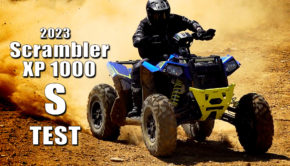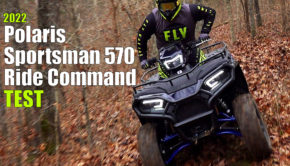2012 Kymco Maxxer 450 4×4 Test
Taking something for granted is most often considered a bad thing. ATVs that can be taken for granted, though, are often the most desirable ones to own. For over a year, we’ve had possession of a 2010 Kymco Maxxer 375 that has seen quite a bit of use. After testing it, the Maxxer provided a learning machine for several riders, and we turned to it often when looking for a reliable, wet-weather trail machine.
While it hasn’t been abused, the Maxxer hasn’t always been treated gently. For the 375’s hard work, it’s been repaid with a diet of sometimes-stale pump gas, a few oil changes, and a good air filter cleaning every couple rides. Since receiving it, we are happy to report no mechanical failures, with the exception of a broken tie rod end after hitting an unexpectedly nasty ditch. We felt the Maxxer 375 proved itself very tough.
Last year, Kymco took the 375’s chassis and installed a water-cooled, 443cc four-valve, single overhead cam, four-stroke engine, fed by fuel injection, bringing life to the new 450. Power output on the 450 is a claimed 33hp–– 7 more than the 26 Kymco claims on the 375’s engine.

Around the time the 375’s acceleration starts tapering off, the 450 has a small surge in its power band, making faster trails more fun with the 450.
Electric start brings the new engine to life. Its fuel injection system runs clean and crisp when warmed up, but we managed to flood our engine on a couple occasions after starting it repeatedly when cold. We pulled the plug, dried it off, let the cylinder air out, reinstalled the plug, and we were good to go. We now make sure we warm it up thoroughly the first time we start it, and have yet to flood it since.
Power output on the fuel-injected 450 is notably stronger than the 375’s. We drag raced both machines repeatedly with 190 and 240 pound test riders. The 450 is faster out of the hole and its performance advantage grows the higher you get in the RPMs.
Power delivery on the 450 is very smooth, making it as easy to ride as the 375 in tight situations. Around the time the 375’s acceleration starts tapering off, the 450 has a small surge in its power band, making faster trails more fun with the 450.
The 450’s CVT transmission features high and low ranges, plus neutral and reverse, selected by a gated shifter. The transmission engages low in the RPMs. Combined with the engine’s good low-end torque, low range isn’t needed unless you’re towing something heavy. Overall, the CVT’s settings were quite good. Our only complaint with the tranny is that Kymco still locates the CVT’s vent hose under the seat, making it susceptible to water crossings where the water’s depth nears the bottom of the seat. Excessive splashing in deep puddles can also result in a wet, slipping drive belt. Wet trails are no problem, but you’ll want to be careful around water.
 Selectable two and four-wheel drive are accessed by a button on the right handlebar. The magic button is a great asset on sometimes dry, sometimes mucked-up trails, allowing you to switch between two and four-wheel drive on the fly. The limited slip on the 450’s front end seems to slip less than the differential on the 375. This increases traction in challenging conditions, but makes steering slightly stiffer in four-wheel drive.
Selectable two and four-wheel drive are accessed by a button on the right handlebar. The magic button is a great asset on sometimes dry, sometimes mucked-up trails, allowing you to switch between two and four-wheel drive on the fly. The limited slip on the 450’s front end seems to slip less than the differential on the 375. This increases traction in challenging conditions, but makes steering slightly stiffer in four-wheel drive.
The 450’s steel frame mates up to dual a-arms up front with lower a-arms and large-diameter, single, upper control arms out back. The shocks feature preload adjustment and control 7 inches of suspension travel at all four corners.
 Suspension action on the Maxxer is decent, absorbing bumps of various sizes. The front shocks have too much rebound damping, and we felt its overall action could be more fluid for better small bump absorption.
Suspension action on the Maxxer is decent, absorbing bumps of various sizes. The front shocks have too much rebound damping, and we felt its overall action could be more fluid for better small bump absorption.
In challenging conditions, the Maxxer’s stability helps keep you out of trouble. A rear sway bar combines with the Maxxer’s 43.4- inch width and 47.9-inch wheelbase, providing a very sure-footed handling machine. The Maxxer feels predictable on steep climbs, descents, and side hills. During aggressive cornering, the Maxxer feels like it has a solid rear axle, exhibiting virtually no rear end body roll. There’s a hint of front-end push on aggressive cornering. Steering effort and bump feedback were especially noticeable in rough conditions. Installing steering stabilizer would help the bump feedback.

Dual hydraulic disc brakes up front and a single hydraulic disc brake in the rear slow the Maxxer predictably.
Dual hydraulic disc brakes up front and a single hydraulic disc brake in the rear slow the Maxxer predictably. The front brakes are controlled by a single, right side, handlebar-mounted lever. The rear brake is activated with a left side, handlebar-mounted lever, or a right, side-mounted foot pedal. The hand levers felt good; however, the rear brake pedal is too high to use without lifting your foot off the peg. The brakes offer good power and feel. Combine the strong brakes with the engine’s effective engine braking system and the Maxxer’s speed is easily regulated.
Ergonomics on the Maxxer are well suited to riders of all sizes. Small adults won’t feel overwhelmed and larger riders aren’t cramped while hanging off for corners. The raised metal foot pegs and plastic floorboards provide sure footing and aid in control in rough terrain, allowing your feet to pivot forward or rearward. The seat is wide and plush, working well for casual or aggressive riding. The engine’s midsection is a little wide and the bolts in the right side of the engine protrude a bit. We would switch to allen head bolts to smooth things out.
The Maxxer comes equipped with a number of high-end features. Along with its EFI fed engine, there’s a digital instrument display, sharp looking 12-in., cast aluminum wheels, and sporty 23-in. Maxxis tires. The rims look hot, but are a bit heavy. The lower profile Maxxis tires promote stability and with the aid of four-wheel drive, work well in varying conditions. The machine’s plastic is some of the highest quality available in the industry and is also available in red, black, and white.
While the sport 4×4 doesn’t feature cargo racks as standard equipment, it does feature a full-size, two-inch hitch receiver that rated at 985 pounds of towing.
When blazing trails, we appreciated the Maxxer’s large, aluminum front bumper. The undercarriage of the machine is covered by plastic skid plates. Our test unit’s front skid plate was damaged when we received our unit. The ATV had been used at Kymco’s magazine intro ride earlier this year. We’re not sure what happened to it, but our 375 has held up to several hundred log crossings with little more than some scrapes and scratches.
At $6,599 the Maxxer lacks the appeal of being the least expensive machine in its class; however, it makes up for it by offering the most features for the money. Yamaha’s Grizzly 450 costs a couple hundred dollars less, but it lacks fuel injection, IRS, and the Maxxer’s flashy wheels. While it could use a few additional refinements, the Maxxer 450 takes a step forward in performance compared to the Maxxer 375. After a few months, we found it to have the same rock solid construction Kymco’s have proven to have in the past. For a fun trail machine you can take for granted, we would suggest looking into the 2012 Kymco Maxxer 450.
Manufacturer: Kymco
Model: 2012 Maxxer 450 4×4
MSRP: $6,399
Contact: wwwlkymcousa.com
2012 Kymco Maxxer 450 4x4
Summary: At $6,599 the Maxxer lacks the appeal of being the least expensive machine in its class; however, it makes up for it by offering the most features for the money. Yamaha’s Grizzly 450 costs a couple hundred dollars less, but it lacks fuel injection, IRS, and the Maxxer’s flashy wheels. While it could use a few additional refinements, the Maxxer 450 takes a step forward in performance compared to the Maxxer 375. After a few months, we found it to have the same rock solid construction Kymco’s have proven to have in the past.














